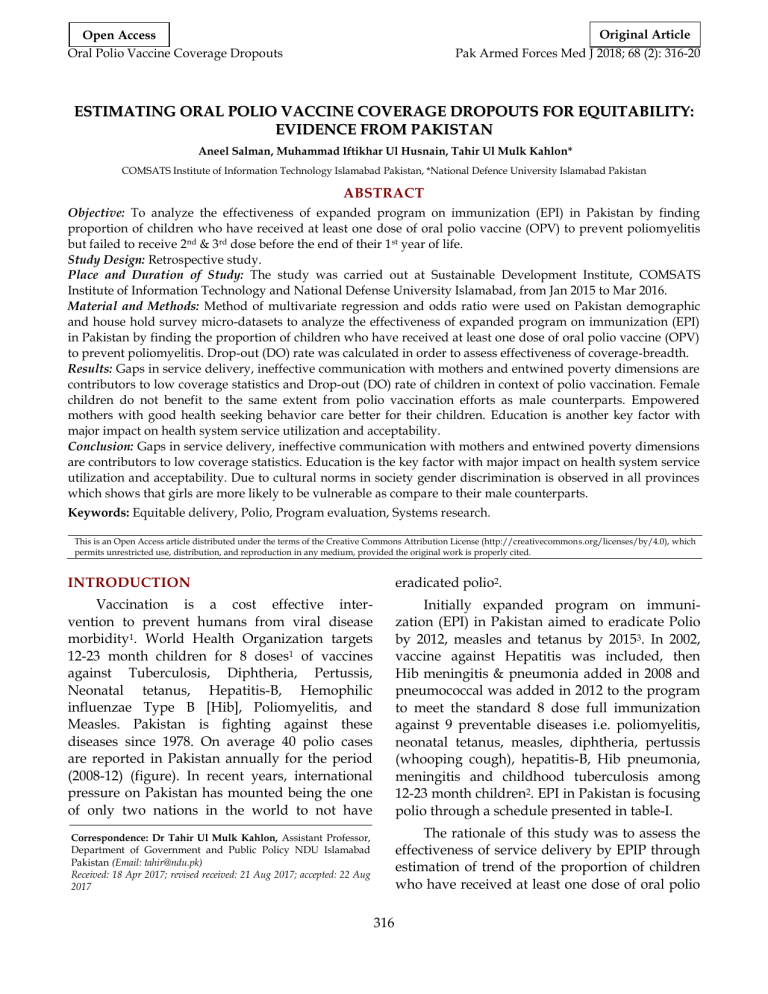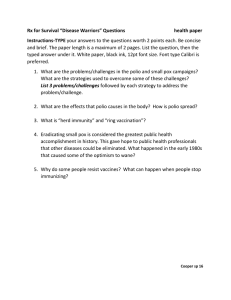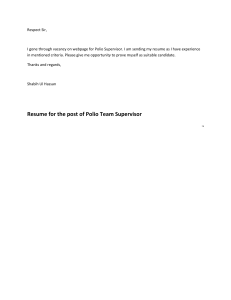
Original Article Pak Armed Forces Med J 2018; 68 (2): 316-20 Open Access Oral Polio Vaccine Coverage Dropouts ESTIMATING ORAL POLIO VACCINE COVERAGE DROPOUTS FOR EQUITABILITY: EVIDENCE FROM PAKISTAN Aneel Salman, Muhammad Iftikhar Ul Husnain, Tahir Ul Mulk Kahlon* COMSATS Institute of Information Technology Islamabad Pakistan, *National Defence University Islamabad Pakistan ABSTRACT Objective: To analyze the effectiveness of expanded program on immunization (EPI) in Pakistan by finding proportion of children who have received at least one dose of oral polio vaccine (OPV) to prevent poliomyelitis but failed to receive 2nd & 3rd dose before the end of their 1st year of life. Study Design: Retrospective study. Place and Duration of Study: The study was carried out at Sustainable Development Institute, COMSATS Institute of Information Technology and National Defense University Islamabad, from Jan 2015 to Mar 2016. Material and Methods: Method of multivariate regression and odds ratio were used on Pakistan demographic and house hold survey micro-datasets to analyze the effectiveness of expanded program on immunization (EPI) in Pakistan by finding the proportion of children who have received at least one dose of oral polio vaccine (OPV) to prevent poliomyelitis. Drop-out (DO) rate was calculated in order to assess effectiveness of coverage-breadth. Results: Gaps in service delivery, ineffective communication with mothers and entwined poverty dimensions are contributors to low coverage statistics and Drop-out (DO) rate of children in context of polio vaccination. Female children do not benefit to the same extent from polio vaccination efforts as male counterparts. Empowered mothers with good health seeking behavior care better for their children. Education is another key factor with major impact on health system service utilization and acceptability. Conclusion: Gaps in service delivery, ineffective communication with mothers and entwined poverty dimensions are contributors to low coverage statistics. Education is the key factor with major impact on health system service utilization and acceptability. Due to cultural norms in society gender discrimination is observed in all provinces which shows that girls are more likely to be vulnerable as compare to their male counterparts. Keywords: Equitable delivery, Polio, Program evaluation, Systems research. This is an Open Access article distributed under the terms of the Creative Commons Attribution License (http://creativecommons.org/licenses/by/4.0), which permits unrestricted use, distribution, and reproduction in any medium, provided the original work is properly cited. INTRODUCTION eradicated polio2. Vaccination is a cost effective intervention to prevent humans from viral disease morbidity1. World Health Organization targets 12-23 month children for 8 doses1 of vaccines against Tuberculosis, Diphtheria, Pertussis, Neonatal tetanus, Hepatitis-B, Hemophilic influenzae Type B [Hib], Poliomyelitis, and Measles. Pakistan is fighting against these diseases since 1978. On average 40 polio cases are reported in Pakistan annually for the period (2008-12) (figure). In recent years, international pressure on Pakistan has mounted being the one of only two nations in the world to not have Initially expanded program on immunization (EPI) in Pakistan aimed to eradicate Polio by 2012, measles and tetanus by 20153. In 2002, vaccine against Hepatitis was included, then Hib meningitis & pneumonia added in 2008 and pneumococcal was added in 2012 to the program to meet the standard 8 dose full immunization against 9 preventable diseases i.e. poliomyelitis, neonatal tetanus, measles, diphtheria, pertussis (whooping cough), hepatitis-B, Hib pneumonia, meningitis and childhood tuberculosis among 12-23 month children2. EPI in Pakistan is focusing polio through a schedule presented in table-I. Correspondence: Dr Tahir Ul Mulk Kahlon, Assistant Professor, Department of Government and Public Policy NDU Islamabad Pakistan (Email: tahir@ndu.pk) Received: 18 Apr 2017; revised received: 21 Aug 2017; accepted: 22 Aug 2017 The rationale of this study was to assess the effectiveness of service delivery by EPIP through estimation of trend of the proportion of children who have received at least one dose of oral polio 316 Oral Polio Vaccine Coverage Dropouts Pak Armed Forces Med J 2018; 68 (2): 316-20 vaccine (OPV) to prevent poliomyelitis, but failed to receive their second and third dose to complete the schedule before the end of the first year of life. months of age. A total of 4811 children were selected using stratified random sampling technique from all three rounds (1215 from 199091, 1522 from 2006-07 and 2074 from 2012-13 round respectively). The sample size was selected on the availability of subjects in the relevant cohort. PDHS collects extensive information on MATERIAL AND METHODS This study was conducted at COMSATS Table-I: Expanded program on immunization in Pakistan immunization schedule. Causes of Disease Vaccine Doses Age of administration infection Childhood Tuberculosis Bacteria BCG 1 0 age or at birth Poliomyelitis Virus OPV 4 OPV-0 : At birth Diphtheria Bacteria Pentavalent Penta-1 : 6 weeks Tetanus Bacteria vaccine (DPT + 3 Penta-2 : 10 weeks Pertussis Bacteria Hep. B + Hib) Penta-3 : 14 weeks Pneumoniae and Pneumo-1 : 6 weeks Meningitis due to Bacteria PCV10 3 Pneumo-2 : 10 weeks S. Pneumonia Pneumo-3 : 14 weeks Measles-1 : 9 months Measles Virus MMRV3 2 Measles-2 : 15months Institute of Information Technology and National Defense University Islamabad from January 2015 to March 2016. This is a retrospective study that utilizes data from three rounds 1990-91, 2006-07, basic health indicators of children under 5 and women of reproductive age i.e. 15 years-49 years. Information about children 12-23 months of age on immunization status; viz, health attributes Figure: Top five countries endemic to Polio virus in five years (2008-12). Source: Annual WHO/UNICEF Joint Reporting Form and WHO; Regional offices report, Update October 2013. 2012-13 of Pakistan demographic health survey (PDHS) to analyze polio dropout incidences. Observation unit comprised of children 12-23 and vaccine uptake is available from “Child vaccination, health and nutrition” section of “Women Questionnaire”. 317 58.8 41.2 97 4.1 95.9 97 84 16 44 89.5 10.5 228 2.6 97.4 228 29.5 70.5 61 90.7 9.3 439 5 95 439 22 78 92 693 1215 392 823 1215 302 96 398 1264 258 1522 107 1415 1522 150 535 685 1769 305 2074 160 1914 2074 139 657 796 N (Total) 522 Secondary and above consistent under assumption that it pertains to those children (12m-23m) who (a) ‘Missed’ i.e. did not receive OPV1, OPV2, OPV3 (b) ‘Discontinued’ i.e. did not receive OPV1 through OPV3 sequentially according to schedule. Hence, coverage for target population remains partial 318 139 79.9 565 83.7 16.3 1118 411 82.2 17.8 1024 91.7 385 82.6 17.4 1050 93 7 1050 13.9 255 79.2 20.8 535 92.5 7.5 535 17.6 82.4 253 83 246 86.9 13.1 575 92.7 7.3 575 13.4 86.6 179 73.2 26.8 407 295 81.7 18.3 964 92 8 964 13.9 86.1 252 77.4 22.6 619 43 67.4 32.6 186 94.1 5.9 186 13.4 86.6 43 64.3 35.7 341 94.3 284 85.9 14.1 844 94.2 5.8 844 11.1 88.9 198 70.7 29.3 510 95.5 4.5 510 16.3 469 81.7 18.3 1044 90.4 9.6 1044 17.9 82.1 444 82.9 17.1 871 91.5 8.5 871 17.3 82.7 221 19.9 N No (%) Yes (%) N No (%) Yes (%) N No (%) Yes (%) N No (%) Yes (%) N No (%) Yes (%) N No (%) Yes (%) N No (%) Yes (%) N Never 20.1 517 90.6 8.3 1024 15.5 86.1 351 79.5 17 496 93.4 5.7 341 17 83.7 152 27.6 80.1 726 No (%) Full doses 93.6 9.4 1118 18.1 84.5 334 76.9 20.5 816 92.9 6.6 619 16 83 25 40 72.4 406 62.8 Yes (%) N No (%) Yes (%) Levels PDHS 2006-07 6.4 517 12.2 81.9 498 79.7 23.1 706 92.9 7.1 407 19.2 84 164 19 60 83 76.1 37.2 726 61.6 38.4 >19 Drop-outs 87.8 126 76.2 20.3 948 93.5 7.1 496 16.3 80.8 118 24.6 81 409 71.1 23.9 406 51.2 48.8 19-24 Never 23.8 346 92.6 6.5 816 15.6 83.7 116 30.2 75.4 358 72.6 28.9 83 46.3 53.7 <25 Full doses 90.9 7.4 706 18.4 84.4 184 21.3 69.8 448 68.7 27.4 409 59.7 40.3 1-2 Response indicator was defined as whether the child (12m-23m) has been dropped out (coded ‘1’) or not (coded ‘0’). Drop-out (DO) rate was calculated in order to assess effectivity of coverage breadth. The DO formula was 96.2 9.1 948 20.1 81.6 214 26.2 78.7 586 62.7 31.3 358 56.1 43.9 3-4 PDHS 1990-91 3.8 346 12.4 79.9 271 23.3 73.8 629 70.3 37.3 448 55.4 44.6 <5 Variables Drop-outs 87.6 83 30.1 76.7 929 65.4 29.7 586 54.2 45.8 Male Mother’s age at 1st marriage Never 69.9 189 60.5 34.6 629 59.8 40.2 Female Birth order Full doses 88.9 39.5 929 61.8 38.2 Uneducated Gender of child Survey Year 11.1 189 41.8 58.2 Primary to Secondary Mother education Oral Polio Vaccine Coverage Dropouts Pak Armed Forces Med J 2018; 68 (2): 316-20 and confounded as failure of planning objective. Difference of ratio between incidences of initial vaccine dose OPV1 and final vaccine dose OPV3 was calculated using the formula; . DO may range Table-II: Percent distribution of children age 12-23 months by their status of vaccination against Polio virus (OPV1-OPV3) and Socio-Demographic characteristics in Pakistan. PDHS 2012-13 Drop-outs “N” sample size for respective category. from 0% to 100%. A decreasing dropout rate would implicate stronger coverage for outcome. Multinomial Logit model was used to find odd ratios that helped to draw comparison across different groups of the sample. As OPV is part of polio campaign yet in Pakistani context it covers Oral Polio Vaccine Coverage Dropouts Pak Armed Forces Med J 2018; 68 (2): 316-20 a substantial part of this activity and hence considered an appropriate measure for polio. Across 1991 to 2013 mother’s age at first marriage was a relevant factor in determination of dropout percentage. Reproductive health care service is significant across the years but father’s education is significant for 1991 and 2013. It insignificantly measures vertical equity for OPV. In 2013, household wealth was a significant characteristic in relation to vaccination intake (table-II). The significance level is based on standard T and F SPSS software (version 18) was used to analyze data. RESULTS Total number of subjects in the study is 4811 selected from three rounds of PDHS based on the availability of subjects in the relevant cohort. Table-III: Odds ratio of immunization status among children 12m-23m by their Background Characteristics. PDHS 1990-91 PDHS 2006-07 PDHS 2012-13 Predictors Full Drop Full Drop Full Drop Never Never Never doses outs doses outs doses outs Regions PUNJAB (Reference) Sindh 0.432 2.619 1.359 1.075 1.422 0.520 0.295 5.590 1.168 KPK 0.836 1.388 1.420 0.791 1.862 0.891 0.304 6.537 1.456 Baluchistan 0.415 2.693 1.501 0.302 9.673 0.665 0.151 9.915 GENDER OF CHILD (MaleRef) Female 0.748 1.413 0.860 0.536 1.130 1.209 0.875 1.177 1.225 FATHER’S EDUCATION (Secondary and above Ref) Uneducated 0.897 0.721 2.215 0.536 3.081 1.004 0.721 1.457 1.143 Primary to 0.975 0.726 1.313 0.566 2.489 1.225 1.027 1.212 0.683 Middle MOTHER’S EDUCATION (Secondary and above Ref) Uneducated 1.004 8.447 0.259 0.511 1.853 1.308 0.837 0.986 0.742 Primary to 1.439 2.337 0.315 0.811 1.188 1.111 0.841 1.066 1.112 Middle GENDER OF HH’HEAD (MaleRef) Female 1.982 0.800 0.336 1.553 0.304 0.926 0.775 1.871 0.788 WEALTH STATUS (RichRef) Poor 0.309 3.351 2.057 1.291 0.902 0.553 0.706 1.504 0.806 Middle 0.533 2.155 0.703 1.707 0.432 0.432 0.891 0.897 1.068 Sample size 1215 1215 398 1522 1522 685 2074 2074 796 N=4811 (Punjab:700, 865,1224) (Sindh: 215, 372, 437) (KPK: 168, 222, 309) (Baluchistan: 132, 63, 104) First, percented distribution of children age 12-23 months by their status of vaccination against polio virus (OPV1-OPV3) and socio-demographic characteristics in Pakistan were present in table-II. Then, deterministic probabilities were calculated of maternal variables and marital age, level of reproductive health care, health seeking behavior, education level, household size in nuclear family, and household wealth were found significant (p=0.03). In 2007 and 2013, reported drop outs are more for children delivered at health facility. Same year, 11% never vaccinated against polio and 66% dropped out. statistics. A significant difference in polio immunization was found among the regions of Pakistan with Baluchistan performing poorest of all. From 1991 to 2013, probability of polio dropouts increased. The highest one was observed in 2007 where children were nearly 10 times more likely to dropout (OR 9.673; 95% CI: 4.758-19.664) as compared to Punjab (table-III). DISCUSSION Poor parental knowledge about child health preventive measures, poor geographical access 319 Oral Polio Vaccine Coverage Dropouts Pak Armed Forces Med J 2018; 68 (2): 316-20 to health services, lack of technical skill of health staff, lack of resources/logistics, misconceptions in population, fear of side effects, conflicting priorities, socio-cultural norms, missed opportunities and unreliable services can be considered responsible for under coverage of vaccination4. Previously the education of mother had been proved as a significant factor affecting immunization status of children5. Inversely speaking the dropout percentage is increasing as level of mother’s education decreasing. This finding is in line with previous studies on the subject6. Households headed by female were less likely to remain unvaccinated during Polio campaigns7 (table-III). incapacity of stewardship and deteriorated security situation especially in north-western regions are hampering performance by health departments in Pakistan8-10. CONCLUSION Gaps in service delivery, ineffective communication with mothers and entwined poverty dimensions are contributors to low coverage statistics. Education is the key factor with major impact on health system service utilization and acceptability. Due to cultural norms in society gender discrimination is observed in all provinces which shows that girls are more likely to be vulnerable as compare to their male counterparts. Different trends among full and no vaccination coverage categories were observed in contrast to drop out cases. This shows that determinants of full, partial and no immunization are different. Increased dropout rates for births at health facilities indicate unsatisfactory service delivery status. Improved probability to vaccination exists for highly educated parents, male children and male head of households. Gender discrimination is due to cultural norms in society. Among all indicators mother’s age at marriage, reproductive health care behavior of mothers, parental education, household size and wealth status of mothers were statistically significant and most influential variables. Results of multivariate analysis suggest that improvement in socioeconomic status of women will decrease the chance of polio dropout cases hence improving service delivery and implementation of vaccination program. CONFLICT OF INTEREST This study has no conflict of interest to be declared by any author. REFERENCES 1. Ozawa S, Mirelman A, Stack ML, Walker DG, Levine OS. Cost effectiveness and economic benefits of vaccines in low and middle income countries: A systematic review. Vaccine 2012; 31(1): 96-108. 2. World Health Organization 2014. Poliomyelitis: Fact sheet. Available at http://www.who.int/mediacentre/factsheets/ fs114/en/ 3. Sheikh A, Iqbal B, Ehtamam A, Rahim M, Shaikh AH, Usmani HA, et al. Reasons for non-vaccination in pediatric patients visiting tertiary care centers in a Polio-prone country. Archives of Public Health 2013; 71(1): 19. 4. Favin M, Steinglass R, Fields R, Banerjee K, Sawhney M. Why children are not vaccinated: A review of the grey literature. International Health 2012; 4(4): 229-38. 5. Basaleem HO, AL-Shakkaf KA, Shamsuddin K. Immunization coverage and its determinants among children 12-23 months of age in Aden Yemen. Saudi Med J 2010; 31(11): 1221-26. 6. Sekhar B, Manju R, Timothy DB. The impact of the national Polio immunization campaign on levels and equity in immunization coverage: Evidence from rural North India. Soc Sci Med 2003; 57(10): 1807-19. 7. Patra N. Universal immunization programme in India: The determinants of childhood immunization 2012. Available at SSRN 881224. 8. Mangrio NK, Alam MM, Shaikh BT. Is expanded programme on immunization doing enough? Viewpoint of health workers and managers in Sindh, Pakistan. J Pak Med Assoc 2008; 58(2): 64-7. 9. Pakistan 2009a. National Health Policy 2009, Final draft. Ministry of Health. Islamabad. Available at http://www. health. gov.pk/ 10. Masud T, Navaratne V. The Expanded Program on Immunization in Pakistan, Recommendations for Improving Performance. HNP discussion paper. 2012 (http:// relief web. int/ sites/reliefweb. int/ files/resources/ The% 20 expanded% 20program% 20on% 20 immunization% 20in% 20 Pakistan. pdf). Behavior change modification and family planning are the most important strategies to improve outcomes of immunization drive against polio virus. Mismanagement within tall structure health system, misallocations and inappropriate utilization of available resource for access to immunization services, irregular monitoring and evaluation, lack of literacy or awareness, 320


